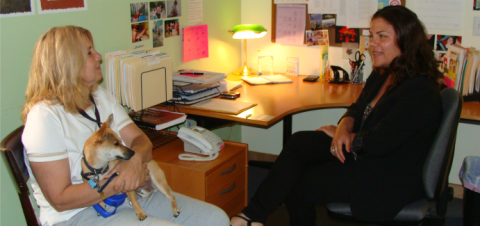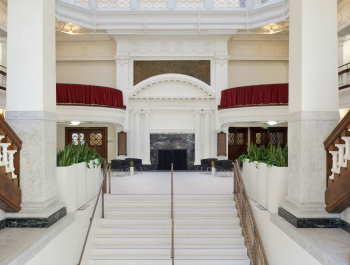Image

Donald S. Falk, CEO, Tenderloin Neighborhood Development Corporation
Challenge: To address problems associated with the homeless population in San Francisco, in the most expensive housing market in the country during the Great Recession that followed the 2008 housing market crash.
Our goal was lofty: to provide housing to serve homeless people in the country’s most expensive housing market during the recession that followed the 2008 housing market crash. We also sought to restore a seismically vulnerable, vacated structure that had long served as a focal point for the Tenderloin community. The plan was to renovate the city’s historic former Central YMCA, a nine-story structure built in the classical style in 1910.
The project required coordination with an array of stakeholders, including the city and county of San Francisco, in the largest affordable housing renovation in the city’s history. In addition to the significant financing challenges, the adaptive reuse project demanded complex architectural and construction planning to update 100-year old building systems in order to both meet our space needs and comply with stringent historic preservation rules.
While Tenderloin Neighborhood Development Corporation (TNDC) had a strong record in real estate development, this project represented the largest and most complex in our 35-year history. Needing to generate $95 million from a dozen sources, capital and operating funding was a monumental challenge. Each funding source presented its own, often-conflicting requirements and spending caps, and equity investors— both for the low income and historic tax credits— were unwilling to risk supporting such a large-scale project during a perilous economic period. Ultimately, the American Recovery and Reinvestment Act made the project possible, providing over $50 million in tax credit financing in the face of the investor community’s unwillingness to finance the project.
After seven years and more than $90 million, the result was Kelly Cullen Community, named after the TNDC’s late, iconic executive director. It provides 127,000 square feet of residential space (172 units), an 11,700 square-foot health center, and a team of nearly a dozen social workers and nurses that operate on site. In keeping with the historic uses of space, dating back to its 1910 design, the project also resulted in the restoration of every element of the architecturally meaningful building, including the auditorium, gym, atrium lobby, meeting spaces and grand staircase. More than 30 percent of the building’s square footage is devoted to community space.
“Being homeless since 1999, going through all the things I was going through, it [Kelly Cullen Community] is very important,” says Sean Williams, a resident since 2012. “It’s giving you a sense of responsibility because this is the first time I’ve had a place of my own. I tell everybody here: ‘I got a big ‘ol mansion.’”
The Tom Waddell Urban Health Clinic, occupying part of the ground floor, makes explicit the project’s connection between housing and health. Built by TNDC for, and operated by, the San Francisco Department of Public Health, it provides medical, psychological and social services for residents of Kelly Cullen as well as an annually anticipated 25,000 patients from the community.
 Kelly Cullen Community represents a national model for its integration of housing and supportive services in a building dedicated 100 percent to formerly homeless residents with chronic health problems. A multi-agency team of social workers and nurses, with TNDC as the lead coordinator, provides health and property management services to tenants of Kelly Cullen, including medical, mental health, money management and substance-abuse treatment.
Kelly Cullen Community represents a national model for its integration of housing and supportive services in a building dedicated 100 percent to formerly homeless residents with chronic health problems. A multi-agency team of social workers and nurses, with TNDC as the lead coordinator, provides health and property management services to tenants of Kelly Cullen, including medical, mental health, money management and substance-abuse treatment.A coordinated model to reduce the public costs of high hospitalization use for homeless individuals, the $1 million annual subsidy to fund services and subsidize the rents of the formerly tenants represents a lower cost to the city than if its residents were to remain in shelters and on the street. The Department of Public Health directs to the building 50 people who are among the highest cost users enrolled in the San Francisco Health Plan.
Kelly Cullen Community makes explicit the critical connections between health and homelessness. New York University researchers, with the support of the Corporation for Supportive Housing, which selected the project for one of its Social Innovation Fund grants, are undertaking a formal evaluation of the effectiveness of Kelly Cullen and three similar programs. The evaluation may build the evidence base to support further the cost effectiveness of housing-first models that link community health and housing systems.
The success of the supportive housing model is the principal lesson learned from Kelly Cullen Community: Providing a stable housing platform with integrated supportive services for homeless individuals is more effective and less costly than allowing them to remain homeless. Supportive housing reduces costs otherwise borne by the public by reducing hospitalizations and other costs associated with caring for vulnerable populations.
Kelly Cullen Community has restored a treasured historical asset for community use, while providing a platform for homeless residents to stabilize their lives. Marcia Sims, a Kelly Cullen resident since January 2013, echoes this transformation. “I like being independent and that’s what it gives me here,” she says. “It’s a community, it’s beautiful. This is my home, this has given me a great sense of direction again.”

